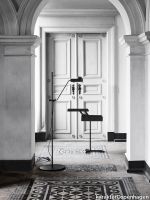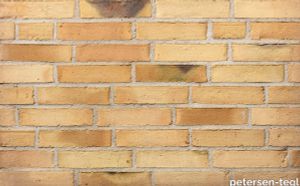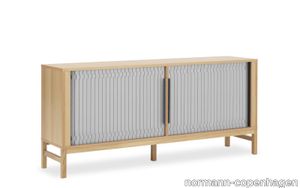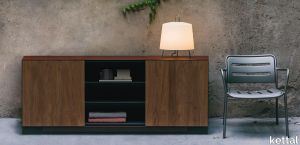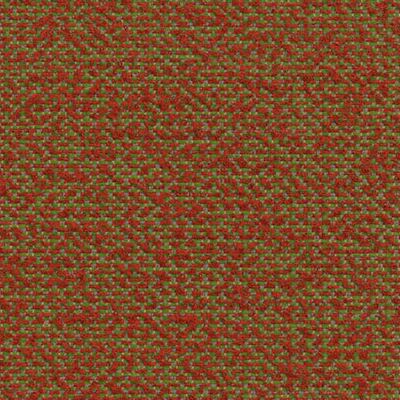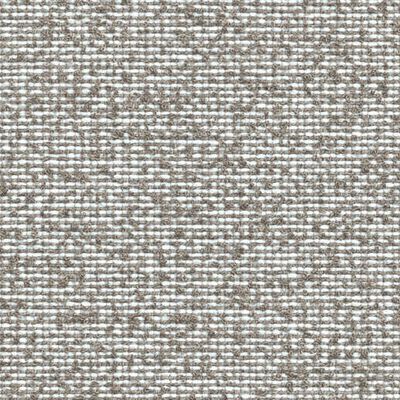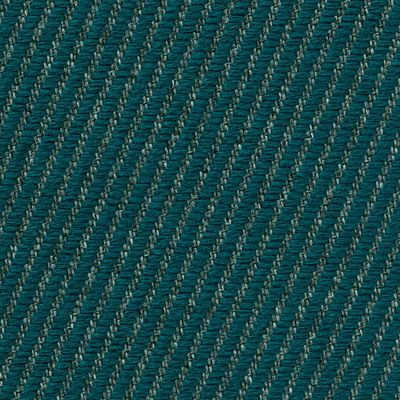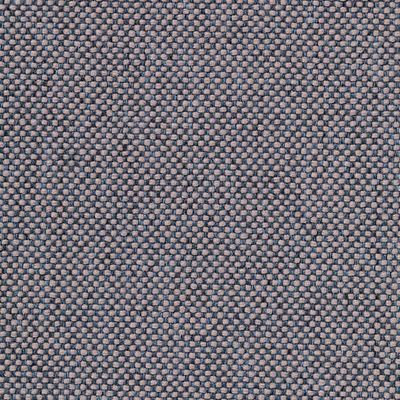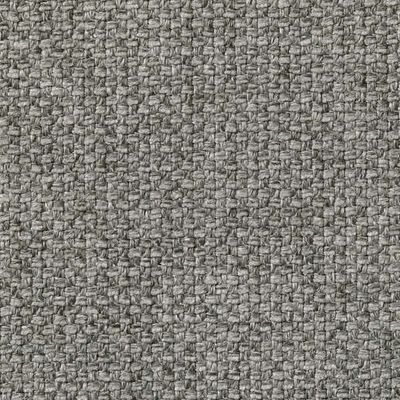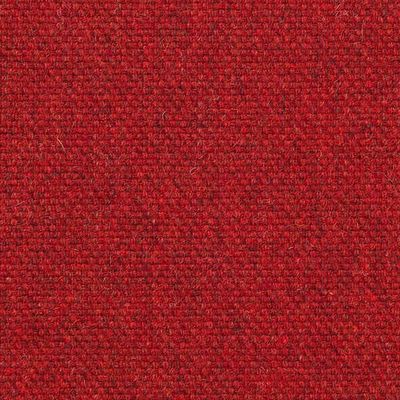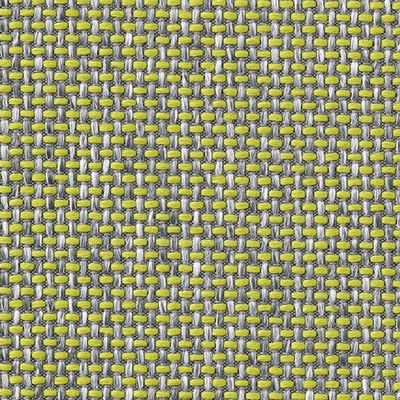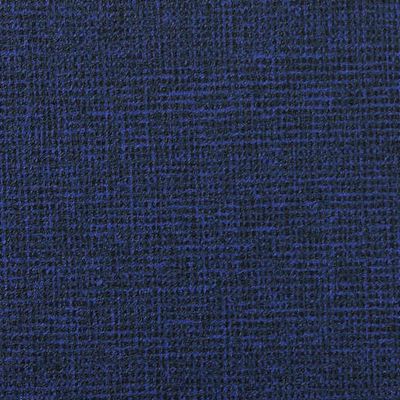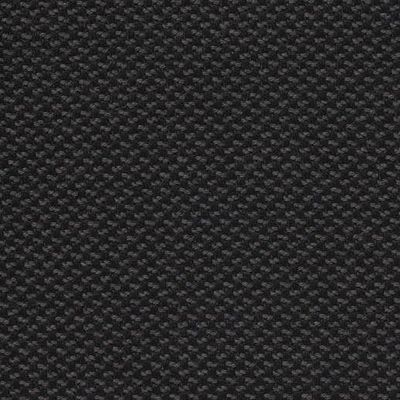PRODUCT DESCRIPTION
Poised on a slim metal stem, Comodo’s wood cabinet is set off-centre with a lidded compartment. Castiglioni and Pozzi’s elegant multi-purpose unit can be used as a bedside table, a tray, a coffee table or simply as a storage box for all your favourites. Supposedly Castiglioni, being a big fan of sweets, used his own Comodo to store candy.
SUPPLIER: KARAKTERCOPENHAGEN
TYPE: FURNITURE

OTHER SUPPLIERS
A wide range of product from near to 3,000 suppliers around the world.






Other Products From This Supplier
A wide range of product from furniture to finishes to meet the desire of all designers.
Jazz Max Brüel, 1961

karakterCopenhagen > Styling
Elegant and with a hint of whimsy, the modular candleholder Jazz was conceived in 1961 by Danish architect, ceramist and jazz musician Max Brüel. A slender, graceful silhouette in three heights, Jazz is an elegant addition to the home – by itself or in groups. A Jazz candleholder comes with a top, a base and three interchangeable stems in different heights to fit any occasion.
Office Desk Bodil Kjær, 1959

karakterCopenhagen > Desk
We are proud to present our first design from a Danish designer. In this case, Danish architect, professor, and designer, Bodil Kjær. The iconic desk, designed in 1959, was the first of its kind with its pure and simplistic design, almost floating mid-air. Bodil Kjærs’ design has been called ‘The most beautiful desk in the world’ – or, the ‘James Bond desk’ as it was featured prominently in three early Bond movies.
Scarpa 925 Afra & Tobia Scarpa, 1966

karakterCopenhagen > Chair
The iconic 925 Scarpa lounge chair is a strikingly elegant lounge chair. Easily recognized by its firm and robust wooden frame and the striking contrast it creates to the lightness of the leather covered seat and backrest. The anatomical design of the leather-covered seat, combined with the natural elasticity of the cantilevered backrest, creates a lounge chair that is equally comfortable and strikingly elegant. The 925 Scarpa lounge chair was designed alongside the charming 121 Scarpa dining chair from 1965. The two chairs are a prime example of Afra and Tobia Scarpa’s work and share the same double trestle structure with characteristic rounded joints. Both designs are now a part of the Karakter collection.
Sferico Joe Colombo, 1968
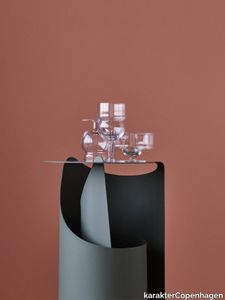
karakterCopenhagen > Styling
Joe Colombo believed in democratic and functional design. In his lifetime he designed a wide range of different drinking glasses. Something that seems very to the point as he was said to love drinking and smoking. Unfortunately this undoubtedly contributed to his young demise, but we’d like to think he would be pleased to see that his creations live on. In 1968 he designed a series of six glasses, all based on geometrical figures. True to his democratic and functional take on design, all the glasses were intended for a wide range of different usage—such as water, long drinks, whisky, wine, beer, juice, champagne, ice cream and so on. Karakter is proud to bring some of the very finest glasses to your table and will introduce the six different Joe Colombo glasses.
Heddles throw Karin Carlander, 2022
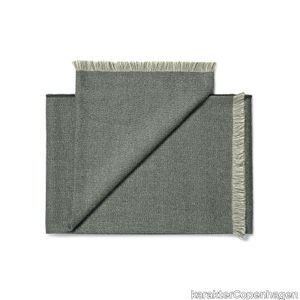
karakterCopenhagen > Styling
Weaver and textile artist Karin Carlander interprets classic techniques as the backbone of her creative process. Two new designs – a rectangular rug woven from paper yarn and a fringed throw in alpaca wool – showcase this craftsmanship in contemporary pieces for the home. When it came to the Heddles throw, Carlander selected alpaca wool from the Andes mountains. These thin, glossy fibers were woven into a luxurious blanket that features a subtle ridged design. Along the throw’s edge, a delicate fringe invites a closer look at the construction process, which sees the loom’s warp and weft working together. “This analogue way of creating is a collaboration between my loom and the material,” says Carlander. “The way threads and colours perform is new and unexpected with each material. Even after so many years, the craft continues to surprise me.”
Scarpa 121 Afra & Tobia Scarpa, 1965

karakterCopenhagen > Chair
The iconic 121 Scarpa dining chair is a straightforward dining chair with a design that can complement both classical and cutting-edge interiors. The design is characterized by a firm and robust wooden frame that creates a striking contrast to the lightness of the seat and back. The seat and back are anatomically shaped in plywood, covered in fine European leather, and attached by bolts to crosspieces along the center for great comfort. Originally inspired by a sketch made by Tobia’s father, Venetian architect and designer, Carlo Scarpa, the 121 came to life with a distinct touch from Afra and Tobia Scarpa in 1965. The 121 Scarpa dining chair was designed alongside the classic 925 Scarpa lounge chair from 1966. The two chairs are a prime example of Afra and Tobia Scarpa’s work and share the same double trestle structure with characteristic rounded joints. Both designs are now a part of the Karakter collection.
Principal dining table Bodil Kjær, 1961

karakterCopenhagen > Table
One of the last living mid-century Scandinavian design pioneers and a female pioneer in the field of architecture in her time, Bodil Kjær, conceived her Principal series in 1961 as part of an architectural exploration of interior solutions for modern living, called Elements of Architecture. Comprising a dining table and an upholstered dining chair, the Principal series epitomises Kjær’s forward-thinking cosmopolitan outlook and modernistic design language that slips fluidly into contemporary interior. The solid wood dining table boasts a clarified form, repeating a simple angle throughout table legs and ends of the table top, while the dining chair with its circular seat and gently rounded backrest, beautifully upholstered, adds a softness to the clear, unfussed geometry, an invitation to linger.
Cross Plex table Bodil Kjær, 1959

karakterCopenhagen > Coffee table
The CrossPlex Low Table was created as part of Kjær’s forward-thinking functional Elements of Architecture furniture program developed between 1955 and 1963. Over the decades this crisp occasional table has retained its timeless appeal, making it a welcome addition to a range of contemporary settings. Constructed of a cruciform acrylic base that supports a square glass top, the inherent transparency of the CrossPlex brings an air of lightness to the room.
Domo Floor Joe Colombo, 1965
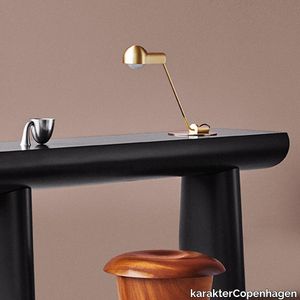
karakterCopenhagen > Floor lamp
The Domo lamp was originally designed by Italian designer Joe Colombo in 1965. Back then he designed three lamps based on the same core shape. Known for his democratic and functional design, his flexible and convertible furniture meant to be used in many different ways – all to the benefit of the user. Joe Colombo experi-mented with new materials and the latest technologies and designed futuristic “machines for living”, many of which have become icons for a new way of living. One of them is Domo. Colombo often rejected sharp corners and straight lines in favour of curvaceous forms.
Domo Table Joe Colombo, 1965
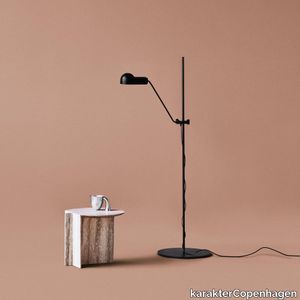
karakterCopenhagen > Table lamp
The Domo lamp was originally designed by Italian designer Joe Colombo in 1965. Back then he designed three lamps based on the same core shape. Known for his democratic and functional design, his flexible and convertible furniture meant to be used in many different ways – all to the benefit of the user. Joe Colombo experimented with new materials and the latest technologies and designed futuristic “machines for living”, many of which have become icons for a new way of living. One of them is Domo. Colombo often rejected sharp corners and straight lines in favour of curvaceous forms.
Bon Aldo Bakker, 2017
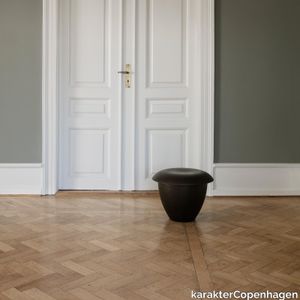
karakterCopenhagen > Stool
A rework of Dutch artist and designer, Aldo Bakker’s wondrous Pink Stool in urushi lacquer from 2015, Bon in stained ash exudes Bakker’s accomplished sense of serene form and materiality. The sculptural stool consists of two contradictive container shapes put together: an upright and deep vertical shape and a flat horizontal shape that defines the seating.
Aida Angelo Mangiarotti, 1988
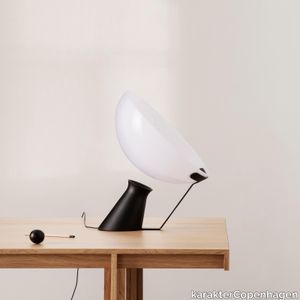
karakterCopenhagen > Table lamp
Esteemed for his researched and controlled approach to materials, Italian architect, sculptor and designer Angelo Mangiarotti created the almost gravity-defying Aida lamp with its visual disconnect between the base and shade and a pleasing ambient light. Referencing principles of his hailed architecture, where slim, elegant pillars support large and heavy ceilings in an almost impossible lift, Mangiarotti conceived Aida’s beautifully poised silhouette.
Hang Around large Derek McLeod,Joy Charbonneau, 2023

karakterCopenhagen > Styling
Hang Around is an updated version of the classic coat rack. Spacious and sturdy, Derek McLeod and Joy Charbonneau’s Hang Around has a soft, rounded expression that contrasts well to the sturdiness of the design. The dedicated pegs and their respective bars will add a welcoming and distinctive vibe to hallways and bedrooms, waiting areas, hotels, and restaurants. Produced in metal, the Hang Around is available in a large version with seven pegs, and in a small version with four pegs.
Lari Angelo Mangiarotti, 1978
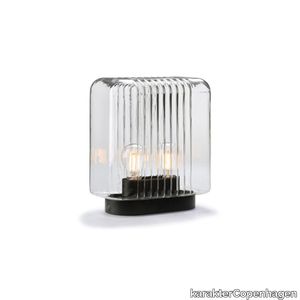
karakterCopenhagen > Table lamp
The Lari Lamp, mouth blown in one single piece, that are held together by the base, which also supports the electrical system evokes, on a small scale, some suggestions of Angelo Mangiarotti’s previous architecture.
Awkward Light Anatomy Design, 2012

karakterCopenhagen > Floor lamp
Quirky and slightly off, Awkward is a floor lamp with a deliberately peculiar anatomy - its long, slender arms reaching to illuminate two areas in close proximity: two sides of a sofa or both an armchair and a desk.
Libreria Pensile Achille Castiglioni,Pier Giacomo Castiglioni, 1957
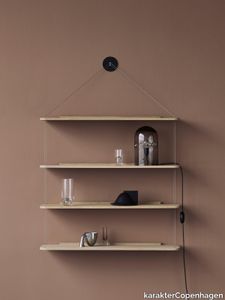
karakterCopenhagen > Cabinet
Originally designed in 1957, perfected over the years, and produced by Bernini in 1966. Seeking to pare down the structure of a bookcase to the absolute minimum, Castiglioni decided to hang the shelves on knots in two cords fixed to a single point on the wall. 50 years after it was launched it is still relevant, elegant, and very Castiglioni.
Pivot Aldo Bakker, 2014

karakterCopenhagen > Styling
Silver with gold on top. A playful and chunky shape with a fine and delicate structure around the lid. All contrasting to the full-blown extravagance of the materials. 100% fine silver, plated with gold. Aldo Bakker, “I question the most common significance of products and thus also their use. In an ideal situation, every object takes on its own character and gains its own legitimacy. My designs are not based on fashion. They are unique pieces, not necessarily understandable at a glance, but meant for a slow, layer by layer exploration.”
Fat One Aldo Bakker, 2015
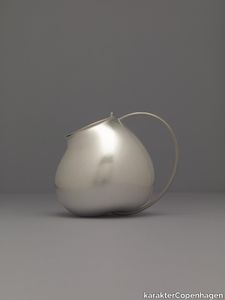
karakterCopenhagen > Styling
“My designs are not based on fashion. They are unique pieces, not necessarily understandable at a glance, but meant for a slow, layer by layer exploration.” Much like all other designs by dutch Aldo Bakker this intriguing shape is designed to surprise. The bottom of Fat One resembles an apple. And where you’ll normally find the stem of the apple, Bakker has connected one end of the handle. The other end is connected to the opening and lid. Fat One is made in silver, bent through electro forming and grown around a perfect model using CNC milling to ensure the precise positioning of the handle. The handle is made in steel, to ensure enough strength to hold the Fat One.
TriAngle Aldo Bakker, 1996

karakterCopenhagen > Stool
The Dutch designer, Aldo Bakker, is known for his uncompromising approach to design. This is a perfect example of his work. TriAngle consists of 12 triangular elements—cut to fit together like the perfect puzzle. The final puzzle reveals a square stool or side table with a distinguished and very precise look. The sharp corners and visible cuts will become softer and gain patina over time, making tear, wear and decay a very essential part of this design. Aldo Bakkers’ work has a delicate and rare sense of harmony and his ideas are always intended to trigger a response. He wants to challenge us with his design, to make us stop our everyday routines for a minute and ponder over an odd little feature, hopefully making us perform our everyday casual acts with more attention.
Chair 300 Joe Colombo, 1965
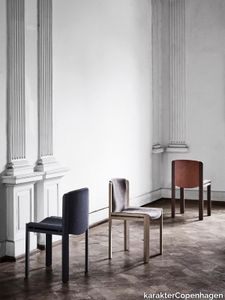
karakterCopenhagen > Chair
Designed by the forward-thinking Italian designer Joe Colombo, Chair 300 is a beautiful example of his functional design sensibility. Upholstered seat and back gently curved inside a modest, clear wooden frame with double horizontal slats give Chair 300 its appealing, comfortable and characteristic look.
Comodo Achille Castiglioni, 1988

karakterCopenhagen > Cabinet
Poised on a slim metal stem, Comodo’s wood cabinet is set off-centre with a lidded compartment. Castiglioni and Pozzi’s elegant multi-purpose unit can be used as a bedside table, a tray, a coffee table or simply as a storage box for all your favourites. Supposedly Castiglioni, being a big fan of sweets, used his own Comodo to store candy.
Lungangolo Achille Castiglioni, 1991
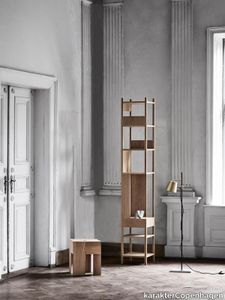
karakterCopenhagen > Styling
Castiglioni is said to ponder a lot on lost space. Empty inches and square meters that could be filled with beautiful design—but for some reason just never were. Due to this thinking he did many designs intended specifically for the corners of the home. Lungangolo is one of those. Lungangolo is a multi-use piece of furniture originally produced by Bernini. The frame is made of four slender pillars with square cross-sec-tions in between to support the square shelves placed in various heights. The structure is strengthened by a drawer and a side piece. The position of the drawer and elimination of part of the support meant it had to be manufactured in two versions—to work for both left and right handed.
Clessidra Vase Joe Colombo, 1969
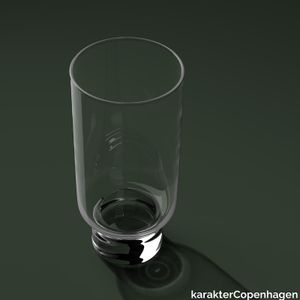
karakterCopenhagen > Styling
Prolific Italian architect and designer Joe Colombo created a wide array of appealing glass objects in his time. He worked with shapes, light, and silhouettes, and had an impressive way of creating small sculptures out of even the most functional homeware pieces. Clessidra vase is a timeless and beautifully scaled glass object, where the container of the vase is raised gracefully from the light base to lift the flowers up in the air. Colombo’s original drawings from 1969 shows a unique idea for a range of multiuse glass objects based on geometrical figures. One of these being the tall, slender Clessidra vase.
Console Table Aldo Bakker, 2017
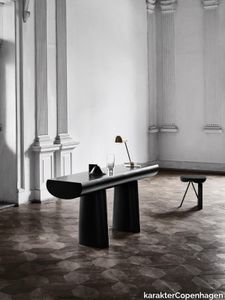
karakterCopenhagen > Console
Tranquil and seductive, Aldo Bakker’s Console Table floats exquisitely between sculpture and furniture. It depicts the simplest concept of a table: two columns and a surface. The legs are an elongation of the line created by the tabletop. The tabletop and the base of the legs have the same width, making them equally important to the design. The distance between the legs is not fixed, but can be changed as preferred, adding to the sculptural quality of this piece.
Coffee Table Aldo Bakker, 2015
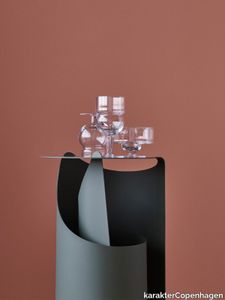
karakterCopenhagen > Coffee table
A single sheet of steel rolled in one smooth motion into a self-supporting construction. Aldo Bakker’s exquisite sense of merging colour, material and form has come into play to create an occasional table with an effortlessly sculptural appeal.
Lab Light Table Anatomy Design, 2010

karakterCopenhagen > Table lamp
The Lab Light design came about from a genuine fascination with laboratory equipment and with all those fantastic clamps and levers — the perfect place to start designing a multi-functional lamp. The base is porcelain, the stem is painted steel, and the lampshade and rotating arm is brass.
Lab Light Floor Anatomy Design, 2010

karakterCopenhagen > Floor lamp
The Lab Light design came about from a genuine fascination with laboratory equipment and with all those fantastic clamps and levers — the perfect place to start designing a multi-functional lamp. The base is porcelain, the stem is painted steel, and the lampshade and rotating arm is brass.
Steel Lab Light Floor Anatomy Design, 2010

karakterCopenhagen > Table lamp
Inspired by her parents’ pharmaceutical work and their old lab equipment, Andrea Kleinloog from Anatomy Design designed the Lab Light mixing steel, brass and porcelain. This brought on a desire to make a lamp with a younger feel. Base, lampshade, and rotating arm—all in painted aluminium.
Steel Lab Light Table Anatomy Design, 2010

karakterCopenhagen > Table lamp
Inspired by her parents’ pharmaceutical work and their old lab equipment, Andrea Kleinloog from Anatomy Design designed the Lab Light mixing steel, brass and porcelain. This brought on a desire to make a lamp with a younger feel. Base, lampshade, and rotating arm—all in painted aluminium.
Middleweight Pouf Michael Anastassiades, 2021
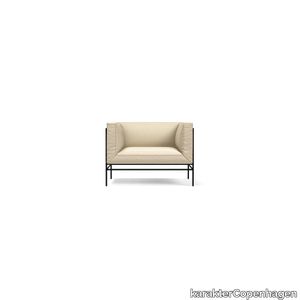
karakterCopenhagen > Chair
The Middleweight sofa captures the best of two worlds, the Italian super lounge sofa on one side and the compact Danish box sofa on the other. Set on a thin, open steel frame, the cushions are firmly held together by zippers and carefully mitered in the corners of the frame, resembling the sharp edges of folded paper. Middleweight is a luxuriously comfortable sofa, available as an arm-chair, 2-seater or 3-seater sofa and pouf. “This was my first sofa design, but actually the biggest surprise didn’t come until the product was finalized – when we stood there, looking at the actual sofa, and it looked exactly like what I had in my head. It is a great satisfaction as a designer. You can’t accelerate the process of design. An idea has to come when the time is right, so you have to stretch the process as long as possible and allow for enough time to get the ideas and experiments across.”
Middleweight armchair Michael Anastassiades, 2021

karakterCopenhagen > Chair
The Middleweight sofa captures the best of two worlds, the Italian super lounge sofa on one side and the compact Danish box sofa on the other. Set on a thin, open steel frame, the cushions are firmly held together by zippers and carefully mitered in the corners of the frame, resembling the sharp edges of folded paper. Middleweight is a luxuriously comfortable sofa, available as an arm-chair, 2-seater or 3-seater sofa and pouf. “This was my first sofa design, but actually the biggest surprise didn’t come until the product was finalized – when we stood there, looking at the actual sofa, and it looked exactly like what I had in my head. It is a great satisfaction as a designer. You can’t accelerate the process of design. An idea has to come when the time is right, so you have to stretch the process as long as possible and allow for enough time to get the ideas and experiments across.”
Middleweight 2-seater Michael Anastassiades, 2021

karakterCopenhagen > Chair
The Middleweight sofa captures the best of two worlds, the Italian super lounge sofa on one side and the compact Danish box sofa on the other. Set on a thin, open steel frame, the cushions are firmly held together by zippers and carefully mitered in the corners of the frame, resembling the sharp edges of folded paper. Middleweight is a luxuriously comfortable sofa, available as an arm-chair, 2-seater or 3-seater sofa and pouf. “This was my first sofa design, but actually the biggest surprise didn’t come until the product was finalized – when we stood there, looking at the actual sofa, and it looked exactly like what I had in my head. It is a great satisfaction as a designer. You can’t accelerate the process of design. An idea has to come when the time is right, so you have to stretch the process as long as possible and allow for enough time to get the ideas and experiments across.”
Middleweight 3-seater Michael Anastassiades, 2021

karakterCopenhagen > Chair
The Middleweight sofa captures the best of two worlds, the Italian super lounge sofa on one side and the compact Danish box sofa on the other. Set on a thin, open steel frame, the cushions are firmly held together by zippers and carefully mitered in the corners of the frame, resembling the sharp edges of folded paper. Middleweight is a luxuriously comfortable sofa, available as an arm-chair, 2-seater or 3-seater sofa and pouf. “This was my first sofa design, but actually the biggest surprise didn’t come until the product was finalized – when we stood there, looking at the actual sofa, and it looked exactly like what I had in my head. It is a great satisfaction as a designer. You can’t accelerate the process of design. An idea has to come when the time is right, so you have to stretch the process as long as possible and allow for enough time to get the ideas and experiments across.”
Rampa Achille Castiglioni,Pier Giacomo Castiglioni, 1965

karakterCopenhagen > Desk
Rampa, a multifunctional station on wheels from 1965, was inspired by the traditional florist’s display stands found on Italian town squares. On one side, the steps serve as a bookshelf with the four steps being covered with tempered glass plates, and a compartment in the lower large step, which is closed with a flap door. At the opposite side of Rampa, there are two visible compartments for storage as well as a larger flap that, when opened, acts as a writing desk, and reveals two more compartments, and six drawers. Thanks to the four castors, two of which has brakes, the object can easily be moved around or fixed.
Side Table No. 2 PlueerSmitt, 2014

karakterCopenhagen > Side table
Striking. Wooden side table consisting of two stripped-down trestles and a table top. The seemingly heavy top contrasts the rigid trestles. The top gives in and provides space for the sharp ends of the trestles to lock the legs and the top together. Intriguing shapes, familiar yet not at all, balancing between art and design. Viewed from different angles the side table varies greatly. A design meant to puzzle our understanding of shape, form and function.
Cache Console Paul McCobb, 1952
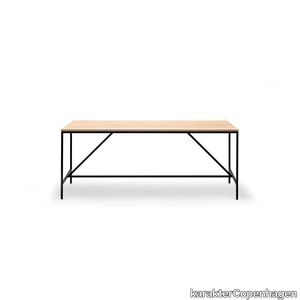
karakterCopenhagen > Console
The foundation of the Cache series, part of Paul McCobb’s extensive Planner series, is a beautifully simplistic and easy table with slim and straight steel legs, stripped from any details or ornament, leaving only small drawers that can be mounted individually or grouped on either side of the table for small keepings. The series is complimented with the matching Desk Organiser with two drawers and a shelf supported by a steel frame. A prominent figure in American mid-century design, Paul McCobb conceived the Planner series in the 1950s, a modular furniture series that brought modern design into middle-class American households. The aesthetic attribute of McCobb’s design is sleek and unadorned and at the same time warm and approachable. With its versatility and purity of form, the Planner series became one of the most successful commercial furniture lines of its era.
Principal chair Bodil Kjær, 1961
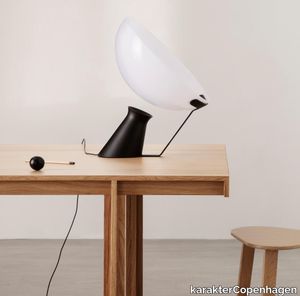
karakterCopenhagen > Chair
One of the last living mid-century Scandinavian design pioneers and a female pioneer in the field of architecture in her time, Bodil Kjær, conceived her Principal series in 1961 as part of an architectural exploration of interior solutions for modern living, called Elements of Architecture. Comprising a dining table and an upholstered dining chair, the Principal series epitomises Kjær’s forward-thinking cosmopolitan outlook and modernistic design language that slips fluidly into contemporary interior. The solid wood dining table boasts a clarified form, repeating a simple angle throughout table legs and ends of the table top, while the dining chair with its circular seat and gently rounded backrest, beautifully upholstered, adds a softness to the clear, unfussed geometry, an invitation to linger.
Cache Dining table Paul McCobb, 1952

karakterCopenhagen > Desk
The foundation of the Cache series, part of Paul McCobb’s extensive Planner series, is a beautifully simplistic and easy table with slim and straight steel legs, stripped from any details or ornament, leaving only small drawers that can be mounted individually or grouped on either side of the table for small keepings. The series is complimented with the matching Desk Organiser with two drawers and a shelf supported by a steel frame. A prominent figure in American mid-century design, Paul McCobb conceived the Planner series in the 1950s, a modular furniture series that brought modern design into middle-class American households. The aesthetic attribute of McCobb’s design is sleek and unadorned and at the same time warm and approachable. With its versatility and purity of form, the Planner series became one of the most successful commercial furniture lines of its era.
Castore dining table Angelo Mangiarotti, 1975
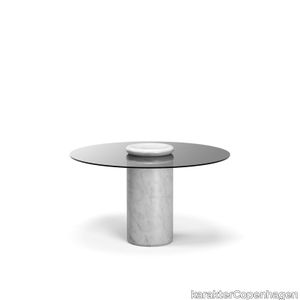
karakterCopenhagen > Table
Castore is a glass and marble table by Italian architect, sculptor and designer Angelo Mangiarotti. Designed in 1975 for Sorgente dei Mobili, the distinct design is now presented by Karakter, available as a 130cm dining table. The round glass top rests on a heavy marble pillar, and visually, Mangiarotti would have it seem that only a small marble bowl on top of the glass plate is holding it in place. The rounded corners on both the pillar and the bowl ads a sense of softness to the otherwise heavy aesthetics of the marble. The marble bowl can be removed and used as an individual element. However, keeping it as an integral part of the design, you can enjoy additional rounded corners, as the bowl reflects in the glass table top.
Cache desk organiser Paul McCobb, 1952

karakterCopenhagen > Cabinet
The foundation of the Cache series, part of Paul McCobb’s extensive Planner series, is a beautifully simplistic and easy table with slim and straight steel legs, stripped from any details or ornament, leaving only small drawers that can be mounted individually or grouped on either side of the table for small keepings. If more storage and distinctiveness is needed, add the second piece in the series, the two-drawer organizer that resides on a slender leg construction as the table itself and has the same playful two-finger opening system as the drawers in the desk. The Desk Organiser can be placed on the desk or used as a stand-alone item next to sofas or beds.
Recently Viewed Products
A wide range of product from furniture to finishes to meet the desire of all designers.
Tip of the Tongue Ceiling and Wall Mounted

michaelanastassiades > Wall lamp
Custom patina available.Tip of the Tongue consists of table lamp, wall lamp and ceiling-mounted sconce, all which feature an interesting illusion: a luminous mouth-blown opaline sphere appears to roll down the edge of a solid polished brass base. This delicate gesture of a sphere poised on the edge of the surface evokes the familiar phenomenon of failing to retrieve a word from memory, expressing a moment of tension in the form of the design. Tip of the Tongue was launched at Euroluce in Milan in 2013. It has gone on to become one of Michael Anastassiades’ most iconic pieces.
Comodo Achille Castiglioni, 1988

karakterCopenhagen > Cabinet
Poised on a slim metal stem, Comodo’s wood cabinet is set off-centre with a lidded compartment. Castiglioni and Pozzi’s elegant multi-purpose unit can be used as a bedside table, a tray, a coffee table or simply as a storage box for all your favourites. Supposedly Castiglioni, being a big fan of sweets, used his own Comodo to store candy.
TIGA - LED dimmable metal outdoor wall lamp _ Deltalight

Deltalight > Wall lamp
The **Tiga** is a versatile outdoor wall lamp designed to provide elegant upward and downward lighting, creating a warm and inviting ambiance on walls. Ideal for both residential and commercial spaces such as hotels and restaurants, Tiga seamlessly blends indoor and outdoor environments with its cohesive design language. Available in three sophisticated finishes—Alu Grey, White, and Dark Grey—this luminaire combines style and functionality. It features energy-efficient LED technology with options for 2700K (779lm) or 3000K (812lm), a high CRI (>90) for excellent color rendering, an IP65 rating for durability, and an Energy Class E rating. A downloadable 3D file of the product is also available for design and planning purposes. Manufactured by **Deltalight**, a renowned Belgian lighting supplier founded in 1987, the company is celebrated for its innovative, high-end lighting solutions that cater to both residential and commercial projects, offering a blend of modern, contemporary, and minimalist designs.
Recommended Products
A wide range of product from furniture to finishes to meet the desire of all designers.
Enfold Sideboard
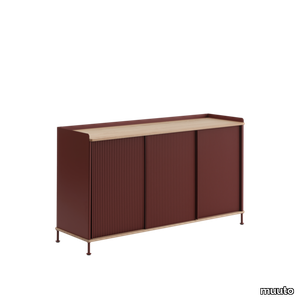
muuto > Cabinet
The Enfold Sideboard combines industrial materiality with residential references for a new perspective on modern storage. Made from a lacquered steel that gently enfolds its top and bottom in solid oak, the Enfold Sideboard fuses cold and warm materials for a unique expression, paired with the vibrantly modern expression of its ridged steel doors. The flexible design is available in four sizes, which all have adjustable shelves and discreet cable outlets. This offers the opportunity to find just the right fit for your space, function and needs — be it a media console, in the hallway or a tall sideboard for storage.
Stacked Storage System Bookshelves
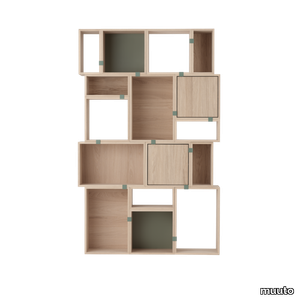
muuto > Cabinet
Being both versatile and functional, the Stacked Storage System can be arranged and rearranged for the exact aesthetic and functional needs of any space. Seen here is a selection of predesigned bookshelf configurations that bring modern storage to any home, workplace or hospitality setting. All modules with backboard can be mounted directly onto the wall.
Reflect Sideboard
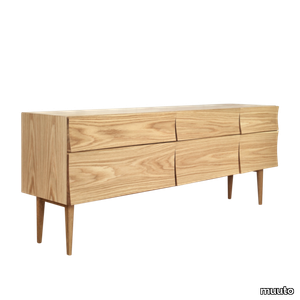
muuto > Cabinet
The Reflect Sideboard is a storage unit with a considerable length that works in both a living room and larger office spaces. With a curved surface in a sturdy frame, the Reflect Sideboard is a modern take on the classic mid-century modern Scandinavian style.
Compile Shelving System Configurations
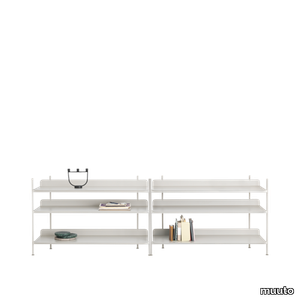
muuto > Cabinet
With its simple and refined expression, the Compile Shelving System features clean lines in a solid construction. The lower wall on the back of each shelf gives the Compile Shelving System an understated sense of detailing along with added functionality. Create your own personal Compile Shelving System from its simple components or choose one of the eight pre-arranged solutions.
Mobil mat

kartell > Cabinet
Winner of the Golden Compass in 1994, the Mobil chest of drawers is presented in a matt version in white, black, green, plum and light blue. The new edition is made of recycled industrial materials, and has the same robust construction and functionality as the original. The basic element of the system is the drawer, alternated with shelves and tops, connected by an aluminium structure. In this new finish, the structure is coloured and the wheels are coloured too, now black instead of grey. This versatile product shouldn’t be restricted to use in the office as it fits perfectly into every room in the home, from the bedroom to the living room and the bathroom too.
CH825 Credenza
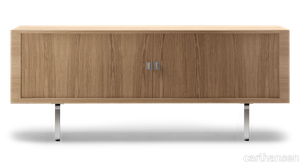
carlhansen > Cabinet
Hans J. Wegners CH825 Credenza from 1959 has an elegant, detailed exterior and a functional interior
FK63 Cabinet
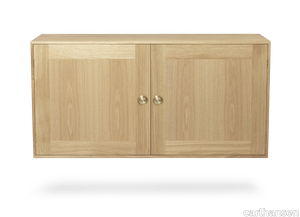
carlhansen > Cabinet
The FK63 Bookcase System, designed by Preben Fabricius and Jørgen Kastholm, embodies Carl Hansen & Søn’s commitment to craftsmanship excellence and timeless design. Devised for maximum flexibility, the different modules can be combined in a multitude of ways to suit every space and need. Visit our customizer to design your own.
Simplon Cabinet

cappellini > Cabinet
The Simplon cabinet, designed by Jasper Morrison, is a sideboard equipped with drawers and hinged doors. The legs are in anodized aluminium, whereas the cabinet is made of poplar plywood lined with aluminium.
Shoji Madia in glass
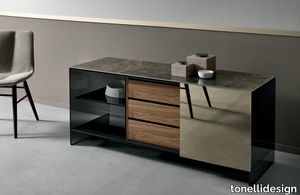
tonellidesign > Cabinet
From the mind of Isao Hosoe and Lorenzo De Bartolomeis the sideboard Shoji Madia is born, a storage unit on castors or fixed base in different heights and lengths, with square and elegant lines. The structure of the storage unit is in smoked glass, and is provided with sliding door/s available in several mirror finishes. The top back panel door or doors can also be in ceramic available in a range of polished or matt finishes. The drawer units in walnut Canaletto, Siberian Ash or Eucalipto, or matt RAL lacquered are optional.
Bookcase Hemingway

tonellidesign > Cabinet
The bookcase Hemingway with its refined and strong shapes was created by architect Massimo Castagna. It is a bookcase with frame in solid wood, made of uprights and beams, wall or ceiling fixing. The uprights are made lighter by frontal and lateral fissures and are characterised by inserts in polished metal. The horizontal beams physically and visually define the shape and rhythm of this bookcase. The structure supports the shelves and storage units available in different functions and dimensions. The bookcase Hemingway can accommodate horizontal storage units with flap opening and vertical units with hinge door, made of glass and wood. It also has a wooden desk top. The glass shelves and their peculiar side slots, are fixed to the uprights through interlocking pins, each shelf is provided with fall arrest security system. Vertical uprights and horizontal beams in solid wood complete the structure and are available in Siberian Ash or Eucalipto, with inserts and supports in polished chrome or gold. The shelves are in extra clear or smoked glass and the feet are height adjustable. Standard heights are 260 and 300cm, also available in custom size, and Tonelli Design proposes shelves in standard size 60 and 100cm. Storage units with flap opening and hinge door with structure in smoked glass and wooden door. Wooden desk top in 100cm, can be fitted out with cable entry. TV module with open storage unit in wood, size 160cm, to accommodate TVs up to 65 inches.
Bookcase Quiller
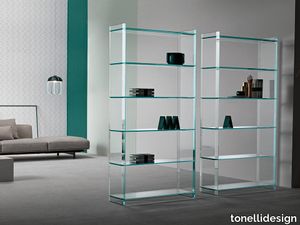
tonellidesign > Cabinet
The bookcase Quiller is made of extra clear bevelled glass and is composed of six shelves closed on the sides. It was designed by designer Uto Balmoral and is perfect to be placed against the wall or free standing in living areas or work spaces. This bookcase is synonymous with lightness and linearity, thanks to the straight shapes and the transparency of the glass, that creates light effects that give brightness to the environment and thus the illusions of greater breadth. It is meant for modern environments and is an excellent match for minimalistic furniture complements.
UPHOLSTERY
A wide range of Upholstery and materials provided by our suppliers to satisfy your needs.
AI services
Fringe Chatbot | Image Finder | Fringe Dall-e | Area Analyzer



